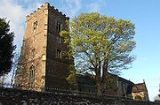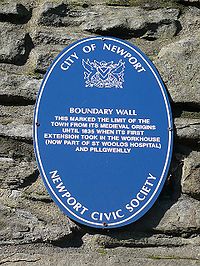
Newport Cathedral
Encyclopedia
Newport Cathedral in the city of Newport
in South Wales
is the cathedral
of the Diocese of Monmouth
, in the Church in Wales
, and seat of the Bishop of Monmouth
. The full title is Newport Cathedral, Woolos, King & Confessor. The Bishop of Monmouth is the Right Reverend Dominic Walker OGS, who has been in post since 2003, when the former bishop, Rowan Williams, was appointed as Archbishop of Canterbury.
, the 5th century Welsh
saint who first founded a religious establishment on the site.
times. In the ninth century the wooden church formerly on the site was rebuilt in stone. This indicates the importance of the cult of Saint
Gwynllyw
and the wealth of his shrine as stone buildings were unusual in Wales at this point. Part of this building is now incorporated into St Woolos cathedral as the Galilee chapel now at the west end of the Cathedral.
Circa 1050 the church was attacked by pirates and left in ruins.
 It was badly damaged in 1402 when Newport
It was badly damaged in 1402 when Newport
was attacked by the forces of Owain Glyndŵr
and underwent a major rebuilding including the addition of the tower.
It also seems to have been damaged in the Civil war
period when a statue above the main entrance representing a benefactor of the church seems to have lost its head. It is either Jasper Tudor, the Earl of Pembroke, or Humphrey Stafford, 1st Duke of Buckingham
as both helped rebuild it after Glyndwr's attack.
In 1929 St Woolos became the Pro-Cathedral of the new Diocese of Monmouth, attaining full cathedral status in 1949.
With the Enthronement of Rowan Williams
as Archbishop of Wales
in February 2000, the Cathedral became the Metropolitan Cathedral for Wales for the third time in its life. The Cathedral continues to serve Wales, the diocese and the City of Newport; it also serves a large parish.
It is also a place of pilgrimage
for political and industrial historians - a plaque in the church yard commemorates the bloody suppression of the Chartist rebellion
here in 1839.
The Dean of Monmouth between March 1997 and May 2011 was the Very Reverend Dr. Richard Fenwick. In May 2011 Dr. Fenwick was consecrated as the Bishop of St. Helena within the Anglican Church of South Africa. The Diocese covers the islands of Saint Helena and Ascension in the Atlantic Ocean.
The Reverend Canon Jeremy Winston has been appointed as the next Dean of Monmouth, and will be installed as Dean during a service at Newport Cathedral on 10th September 2011.
Newport
Newport is a city and unitary authority area in Wales. Standing on the banks of the River Usk, it is located about east of Cardiff and is the largest urban area within the historic county boundaries of Monmouthshire and the preserved county of Gwent...
in South Wales
South Wales
South Wales is an area of Wales bordered by England and the Bristol Channel to the east and south, and Mid Wales and West Wales to the north and west. The most densely populated region in the south-west of the United Kingdom, it is home to around 2.1 million people and includes the capital city of...
is the cathedral
Cathedral
A cathedral is a Christian church that contains the seat of a bishop...
of the Diocese of Monmouth
Diocese of Monmouth
The Diocese of Monmouth is a diocese of the Church in Wales. Despite the name, its cathedral is located not in Monmouth but in Newport — the Cathedral Church of St Woolos. Reasons for not choosing the title of Newport included the existence of a Catholic Bishop of Newport until 1916...
, in the Church in Wales
Church in Wales
The Church in Wales is the Anglican church in Wales, composed of six dioceses.As with the primus of the Scottish Episcopal Church, the Archbishop of Wales serves concurrently as one of the six diocesan bishops. The current archbishop is Barry Morgan, the Bishop of Llandaff.In contrast to the...
, and seat of the Bishop of Monmouth
Bishop of Monmouth
The Bishop of Monmouth is the diocesan bishop of the Church in Wales Diocese of Monmouth.The see covers the historic county of Monmouthshire with the bishop's seat located at the Cathedral Church of Saint Woolos in Newport, which had been elevated to that status in 1921.The Bishop's residence is...
. The full title is Newport Cathedral, Woolos, King & Confessor. The Bishop of Monmouth is the Right Reverend Dominic Walker OGS, who has been in post since 2003, when the former bishop, Rowan Williams, was appointed as Archbishop of Canterbury.
Saint Woolos
The name "Woolos" is a corruption of GwynllywGwynllyw
Saint Gwynllyw Milwr or Gwynllyw Farfog, known in English in a corrupted form as Woolos the Warrior or Woolos the Bearded was a Welsh king and religious figure....
, the 5th century Welsh
Welsh people
The Welsh people are an ethnic group and nation associated with Wales and the Welsh language.John Davies argues that the origin of the "Welsh nation" can be traced to the late 4th and early 5th centuries, following the Roman departure from Britain, although Brythonic Celtic languages seem to have...
saint who first founded a religious establishment on the site.
Pre-Norman establishment
The present building has sections that date from Anglo-SaxonAnglo-Saxon
Anglo-Saxon may refer to:* Anglo-Saxons, a group that invaded Britain** Old English, their language** Anglo-Saxon England, their history, one of various ships* White Anglo-Saxon Protestant, an ethnicity* Anglo-Saxon economy, modern macroeconomic term...
times. In the ninth century the wooden church formerly on the site was rebuilt in stone. This indicates the importance of the cult of Saint
Saint
A saint is a holy person. In various religions, saints are people who are believed to have exceptional holiness.In Christian usage, "saint" refers to any believer who is "in Christ", and in whom Christ dwells, whether in heaven or in earth...
Gwynllyw
Gwynllyw
Saint Gwynllyw Milwr or Gwynllyw Farfog, known in English in a corrupted form as Woolos the Warrior or Woolos the Bearded was a Welsh king and religious figure....
and the wealth of his shrine as stone buildings were unusual in Wales at this point. Part of this building is now incorporated into St Woolos cathedral as the Galilee chapel now at the west end of the Cathedral.
Circa 1050 the church was attacked by pirates and left in ruins.
Norman history
Circa 1080 the Normans built a new nave to the east of the Saxon ruins, and a lean-to south aisle, building a new entrance archway through the Saxon wall. Circa 1200 the Saxon church was repaired so the Norman entrance became an internal archway.Mediæval history

Newport
Newport is a city and unitary authority area in Wales. Standing on the banks of the River Usk, it is located about east of Cardiff and is the largest urban area within the historic county boundaries of Monmouthshire and the preserved county of Gwent...
was attacked by the forces of Owain Glyndŵr
Owain Glyndwr
Owain Glyndŵr , or Owain Glyn Dŵr, anglicised by William Shakespeare as Owen Glendower , was a Welsh ruler and the last native Welshman to hold the title Prince of Wales...
and underwent a major rebuilding including the addition of the tower.
It also seems to have been damaged in the Civil war
English Civil War
The English Civil War was a series of armed conflicts and political machinations between Parliamentarians and Royalists...
period when a statue above the main entrance representing a benefactor of the church seems to have lost its head. It is either Jasper Tudor, the Earl of Pembroke, or Humphrey Stafford, 1st Duke of Buckingham
Humphrey Stafford, 1st Duke of Buckingham
Humphrey Stafford, 1st Duke of Buckingham KG , an English nobleman, great grandson of King Edward III on his mother's side, was best known as a military commander in the Hundred Years' War and in the Wars of the Roses....
as both helped rebuild it after Glyndwr's attack.
Recent history
It has been partially rebuilt or extended in every period up to the 1960s. It is currently undergoing much-needed repairs and an appeal fund has started. in order to raise the £1.5m urgently needed to rescue and repair this historic building. Repairs to the roof started in February 2011 by Newport based contractor Instaat Projects Ltd, although further fundraising is necessary and other restoration is required to prevent serious dilapidation.In 1929 St Woolos became the Pro-Cathedral of the new Diocese of Monmouth, attaining full cathedral status in 1949.
With the Enthronement of Rowan Williams
Rowan Williams
Rowan Douglas Williams FRSL, FBA, FLSW is an Anglican bishop, poet and theologian. He is the 104th and current Archbishop of Canterbury, Metropolitan of the Province of Canterbury and Primate of All England, offices he has held since early 2003.Williams was previously Bishop of Monmouth and...
as Archbishop of Wales
Archbishop of Wales
The post of Archbishop of Wales was created in 1920 when the Church in Wales was separated from the Church of England , and disestablished...
in February 2000, the Cathedral became the Metropolitan Cathedral for Wales for the third time in its life. The Cathedral continues to serve Wales, the diocese and the City of Newport; it also serves a large parish.
It is also a place of pilgrimage
Pilgrimage
A pilgrimage is a journey or search of great moral or spiritual significance. Typically, it is a journey to a shrine or other location of importance to a person's beliefs and faith...
for political and industrial historians - a plaque in the church yard commemorates the bloody suppression of the Chartist rebellion
Newport Rising
The Newport Rising was the last large-scale armed rebellion against authority in mainland Britain, when on 4 November 1839, somewhere between 1,000 and 5,000 Chartist sympathisers, including many coal-miners, most with home-made arms, led by John Frost, marched on the town of Newport,...
here in 1839.
The Dean of Monmouth between March 1997 and May 2011 was the Very Reverend Dr. Richard Fenwick. In May 2011 Dr. Fenwick was consecrated as the Bishop of St. Helena within the Anglican Church of South Africa. The Diocese covers the islands of Saint Helena and Ascension in the Atlantic Ocean.
The Reverend Canon Jeremy Winston has been appointed as the next Dean of Monmouth, and will be installed as Dean during a service at Newport Cathedral on 10th September 2011.
Organ
A specification of the organ can be found on the National Pipe Organ Register The current organist and Master of the Choristers is Christopher Barton, who has been in post since 1979.Timeline
- c.500: Original church built
- c.800: Church replaced with a stone structure
- c.1050: Attacked by pirates and left in ruins
- c.1080: Normans build nave and archway
- c.1200: Entrance chapel repaired
- 15th century: Tower and aisles built
- c.1650: Monuments damaged by PuritanPuritanThe Puritans were a significant grouping of English Protestants in the 16th and 17th centuries. Puritanism in this sense was founded by some Marian exiles from the clergy shortly after the accession of Elizabeth I of England in 1558, as an activist movement within the Church of England...
s - 1819: Entrance chapel restored
- 1853: Full restoration
- 1854: The new St Woolos CemeterySt Woolos CemeterySt Woolos Cemetery is the main cemetery in the city of Newport, Wales situated one mile to the west of the Church in Wales cathedral known by the same name. It contains four chapels, and various ornate memorials dating back to the early Victorian period, and was the first municipally constructed...
opens 1 mile to the west of the cathedral - 1869: Last burials in the old graveyard in the cathedral ground
- 1913: Full restoration and re-roofing
- 1922: Designated pro-Cathedral of the Diocese of Monmouth
- 1949: Full Cathedral status
- 1962: Victorian Chancel replaced
- 1987: Choir Chapel refurbished
- 1997: Renovation of organ
- 2011: Roof renovation

